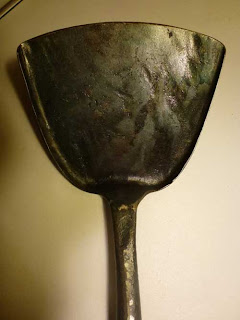Halfway there
Ready for its first stir fry
My Chinese father — a former professional chef before he became a publisher — never bothered with a wok. He did perfectly well with a large aluminium pot that lasted a lifetime.
I'd watched his Chinese friends cooking in clouds of smoking oil, clattering their large blackened round-bottomed woks with the iron "shovels" and, while entertained by the theatre of it, vowed never to put myself through the bother. There's something about the girth of a wok that can take over the average dinky kitchen. Where do you store such giants?
The chief pain that deterred me, though, was the seasoning process, described to me by my mother as some sort of trial which I was bound to fail. I'm told English people had to do this in ye olden days to seal the metal and protect it from oxidisation (rust) before the space age gave us Teflon non-stick. I once had a non-stick wok, as absurd as that seemed to a Chinese person, but was put off when the carcinogenic coating began to flake off under the pressure of high temperature stir-fries. Not healthy, plus it was a cheat.
However, this Christmas, I bought one for a friend who'd been jonesing after one, attracted by the romance and exoticism of cooking as an extreme sport. Rejecting the slinky black non-stick wok sets purveyed by Chinese TV chefs, I selected the most basic and authentic one I could find at the north London Wing Yip, made by Hancock. Lovely! Carbon steel with a wooden handle — no hanging loop, no second handle for the limp-wristed — this was a sturdy workaday kitchen implement I expect to last forever.
The instructions told us (once we'd scrubbed off the anti-rust layer with cream cleanser, rinsed and dried) to pour a tiny bit of vegetable oil in the wok and wipe it round with a kitchen towel to coat the inside thoroughly. Then you place it over a low heat until it darkens. Fifteen minutes they said, presumably not wishing to scare off novices. Fifteen minutes was enough to blacken the bottom (I bought a flat-bottomed one, otherwise you need a support ring — yet more equipment!) but nowhere near enough to affect the curved upper part.
After half an hour of this, he'd had enough and abandoned it to cool on the hob for another go later. (See first pic above)
While he was sulking, I cut to the chase, poured in more oil, slooshed it around (no namby-pamby kitchen roll for me) and emptied the excess down the sink. After shutting all doors and opening windows and back door, I then whacked up the flames on the biggest gas ring as far as they'd go until the oil was smoking: only then did the magic happen. You have to move it around and hold it at angles to make sure the sides get done, but it happens in front of your eyes so it's only a bit like watching paint dry.
To be totally safe (fire, flammable oil, soft human flesh, home) have a large metal lid and a damp tea-towel to hand, just in case. But you should be okay if you don't have more than a coating of oil.
It is now cooling down on the hob, ready for use. Every time you use it it will only get better.


